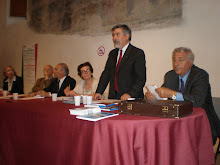Bremerhaven,
11th July 2013. The breakup and collapse of the Larsen A ice shelf in the
western Weddell Sea in 1995 has resulted in fundamental changes to life on the
sea bed in less than two decades. As
reported by biologists from the Alfred Wegener Institute, Helmholtz Centre for
Polar and Marine Research in the cover story of the current issue of the
scientific journal Current Biology, Antarctic glass sponges have been the prime
beneficiaries of the disappearance of the ice shelf. To the surprise of the
scientists, the density of these archaic filter-feeders has increased threefold
between 2007 and 2011 despite only low plankton food supply and water
temperatures of minus 2 degrees Celsius.
The sponges had also grown remarkably quickly and had completely
supplanted competitors for food. The
results show that communities at the bottom of the western Weddell Sea react
considerably more quickly to climate-related changes than previously thought.
Glass
sponges (Hexactinellida), an archaic group of animals at the basis of the
animal kingdom, dominate the shallow seafloor in the Antarctic. Many biologists believed that glass
sponges grew so slowly that two-metre behemoths would have to be around 10,000
years or older. These
assumptions have now been challenged in a new study led by scientists from the
Alfred Wegener Institute (AWI) and published in the current issue of the
scientific journal Current Biology.
During
a Polarstern expedition to the poorly accessible region of the former Larsen A
ice shelf, AWI biologists Laura Fillinger and Claudio Richter, together with
colleagues from the University of Gothenburg and the Senkenberg Research
Institute and Natural History Museum; succeeded in demonstrating that glass
sponges can grow rapidly within a short period of time. “We were surprised by what we saw on
our video screens in 2011 when we lowered our remotely operated vehicle onto
the sea bed at a depth of around 140 metres.
In an area, which had revealed large numbers of ascidians and only
occasional glass sponges during an earlier expedition with the ice-breaking
research vessel ‘Polarstern’ in 2007, four years later we found no ascidians at
all. These pioneer species had
completely disappeared, replaced by three times the number of glass sponges,
including several juvenile individuals”, reports Laura Fillinger, lead author
of the study.
Until
this time scientists had assumed that communities on the Antarctic sea bed only
change very slowly because of the very low temperature (minus two degrees
Celsius) and patchy supply of food in pack-ice covered waters. “We now know that glass sponges may
undergo boom-and-bust cycles, allowing them to quickly colonize new habitats in
a short period of time”, says project leader Prof. Dr. Claudio Richter.
“To
the organisms living on the sea bed, the disappearance of the
hundred-metre-thick Larsen A ice shelf must have been like the heavens opening
up above them”, he adds. Where
cold, darkness and food shortages had previously reigned, sunlight now allows
plankton growth in surface waters and, hence, a rain of food comes down to the
sea bed.
Glass sponges feed on the smallest plankton, which they filter from the
water. The animals grow to a
size of up to two metres, and their vase-like bodies provide perfect hiding,
spawning and shelter opportunities for fish, invertebrates and many other sea
dwellers. “Like corals, sponges
create their own habitats. To an
extent they are like cities on the sea bed. There is something going on
wherever they grow, and this attracts other sea dwellers to them”, says Claudio
Richter.
New
spaces are being created for such underwater worlds wherever the ice shelves on
the Antarctic Peninsula are retreating or breaking up. However, scientists cannot yet
definitively say whether this means that glass sponges will be one of the
beneficiaries of climate change. Laura
Fillinger: “There are still too many unknowns to make predictions. One example is the question of the
influence of competitors: currently we are witnessing a fierce competition for
space on the sea bed. Another
concerns predators: in our dive in 2011 we hardly saw any of the snails and
starfish, which feed on glass sponges. However,
it is possible that these voracious predators will follow suit and wreak
havoc.”








Nessun commento:
Posta un commento